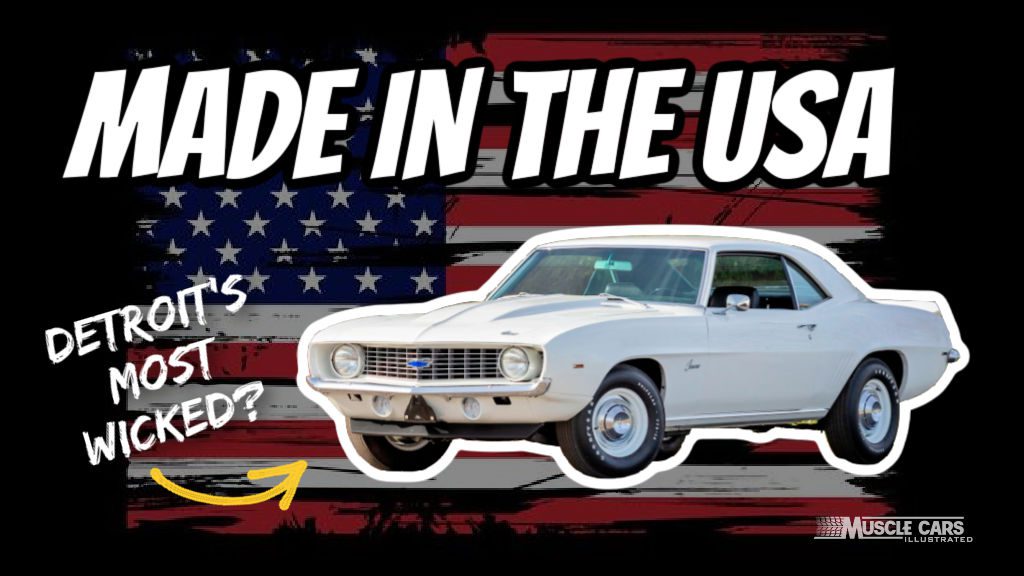
From the engine’s roar to the sleek curves of the body, American muscle cars are an enduring symbol of power, speed, style, and rebellious spirit.
Over the years, these legendary muscle cars, originally known as supercars, have captured car enthusiasts’ and casual drivers’ hearts and imaginations.
It’s fair to say these iconic high-performance vehicles have left a lasting legacy.
Table of Contents
American Muscle Cars that Defined an Era
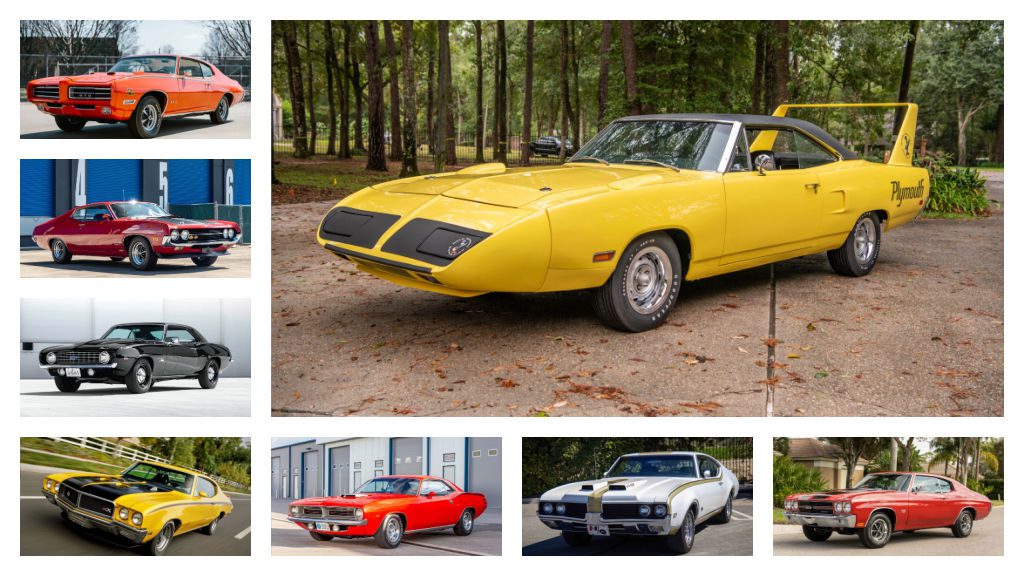
Before we dive into the details of each American Muscle Car, let’s take a moment to appreciate what makes a muscle car a muscle car.
At their core, muscle cars are all about straight-line performance—emphasizing quarter-mile speed. They’re built with high-performance engines and designed to be fast, powerful, and thrilling to drive.
They often have distinctive styling features like hood scoops, racing stripes, hood pins, dual exhaust, and spoilers and come in bold, eye-catching colors.
The muscle car era lasted from 1964 to 1974 and was characterized by producing powerful and high-performance American vehicles known as Muscle Cars.
These cars had large-displacement V8 engines, delivered high horsepower, had whiplash-inducing torque, and provided blistering acceleration.
This distinctive era ended in the early 1970s due to many factors, including stricter emissions regulations, rising gas prices, higher insurance premiums, and changing consumer preferences.
Let’s take a closer look at seventeen of the most badass American Muscle Cars of all time, shall we?
1969 Dodge Charger Daytona
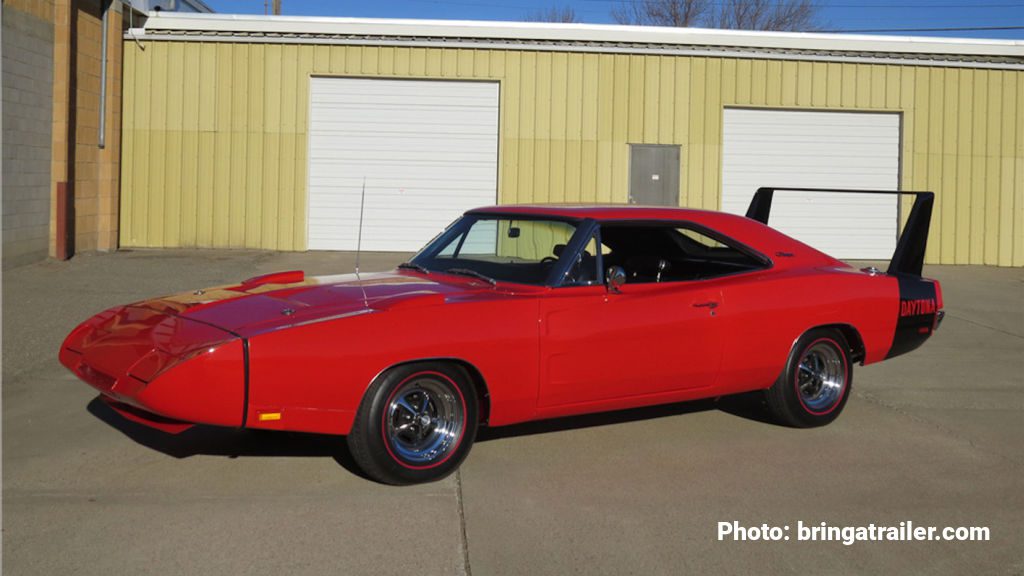
The 1969 Dodge Charger Daytona, based on the Charger, is one of the most iconic and sought-after aero cars ever. Built for high-speed NASCAR oval track racing, the Daytona features a unique aerodynamic design with a long nosecone, fender scoops, and a raised rear spoiler.
The Dodge Daytona was also developed to take advantage of NASCAR’s homologation rules, which required manufacturers to produce 500 street-legal versions of the race car they intended to race.
Under the hood, the car was powered by high-performance engines, including the 426 cubic inch Hemi V8 that could produce up to 425 horsepower. With its powerful engine and distinctive styling, the Daytona became a radical standout.
The car’s aerodynamic design and powerful engine helped it make a big impression on the racetrack, where it set multiple records and earned a reputation as one of the most dominant race cars of its time.
It was the only car that year to reach speeds of up to 200 mph on the racetrack. With only 503 units produced, the Daytona was rare and is highly sought-after today.
1970 Plymouth Superbird 426 Hemi
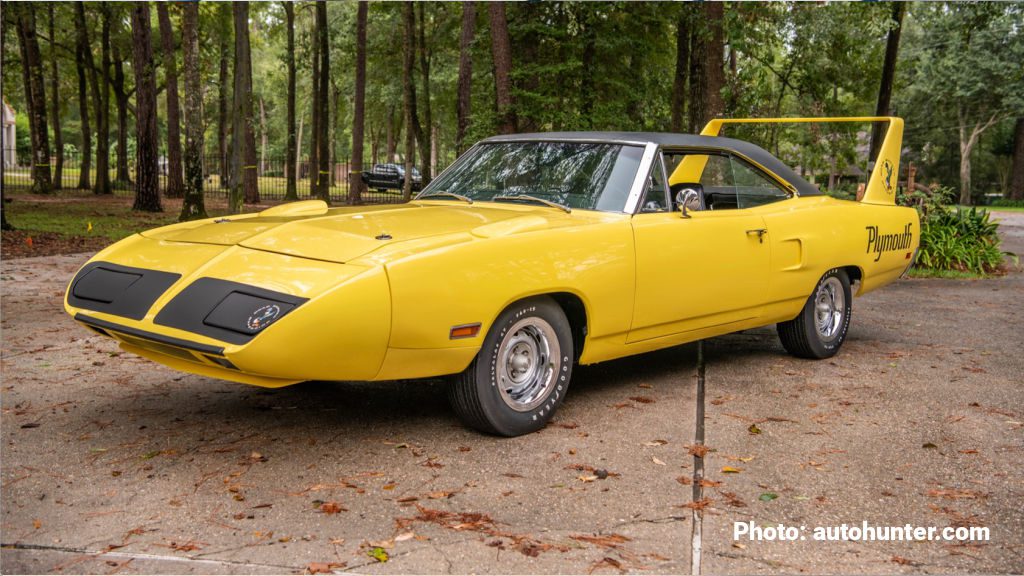
The 1970 Plymouth Superbird is also known for its unique aerodynamic design and impressive performance capabilities.
Based on the Plymouth Road Runner, the Superbird was designed to be a high-speed racing machine featuring a long nosecone and a towering rear spoiler that helped improve handling and reduce drag.
The rear window on the Superbird was significantly different from the Road Runner. The Superbird’s rear window was an aerodynamic sloping design that extended upward to a peak, whereas the Road Runner’s rear window was a standard flat-glass design.
Plymouth created the Superbird to compete with the other manufacturers in NASCAR and to continue the success that the Daytona had achieved. It won a total of 8 NASCAR races during the 1970 season.
Some notable victories for the Superbird include Richard Petty’s win at the 1970 Daytona 500 and multiple victories by driver Pete Hamilton. It competed against other iconic aero cars of the era, like the 1969 Ford Torino Talladega and the 1969 Mercury Cyclone Spoiler II.
Under the hood, the Superbird was powered by a range of high-performance engines, including two 440 cubic inch V8 versions and a 426 cubic inch Hemi V8 that could produce up to 425 horsepower.
These powerful engines and the car’s distinctive styling helped make the Superbird one of its era’s most memorable NASCAR homologation supercars.
Compared to the 1969 Dodge Daytona, the Superbird was a more refined and advanced machine with improved aerodynamics and handling capabilities.
While both cars shared a similar design philosophy and were built for high-speed racing, the Superbird represents an evolution of the era, focusing on improved aerodynamics that helped push the limits of what was possible in a production car.
1970 Chevy Chevelle SS 454 LS6
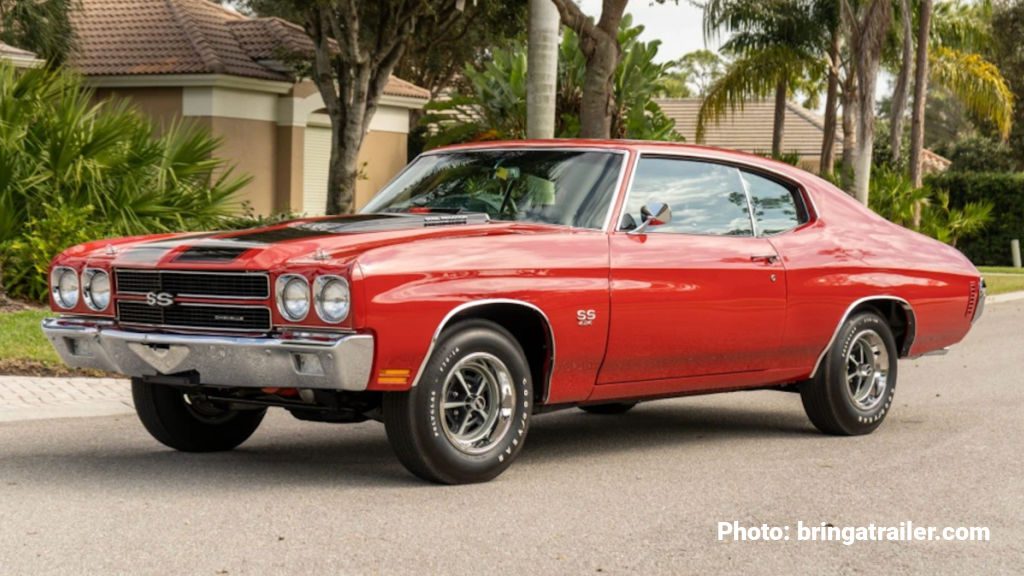
The 1970 Chevy Chevelle SS 454 LS6 had the highest horsepower in the era.
The SS 454 LS6 was powered by a 454 cubic inch V8 engine with 450 horsepower and 500 lb-ft of torque. It was also equipped with various performance upgrades, including a high-performance camshaft, four-barrel carburetor, and high-flow cylinder heads.
These modifications helped the SS 454 LS6 achieve impressive speed and acceleration, making it stand out among its peers.
Chevrolet produced only 4,475 units of the SS 454 LS6 between the hardtop, convertible, and El Camino models.
In terms of performance, the car could reach top speeds of up to 110 mph, with a quarter-mile time of just over 13 seconds. These impressive numbers helped solidify the Chevy 454 LS6 engine’s reputation as one of its era’s most powerful and capable American muscle cars.
Its powerful engine, beefy physique, and impressive speed and acceleration capabilities helped secure its status as the winner of the horsepower wars.
1970 Plymouth ‘Cuda 426 Hemi
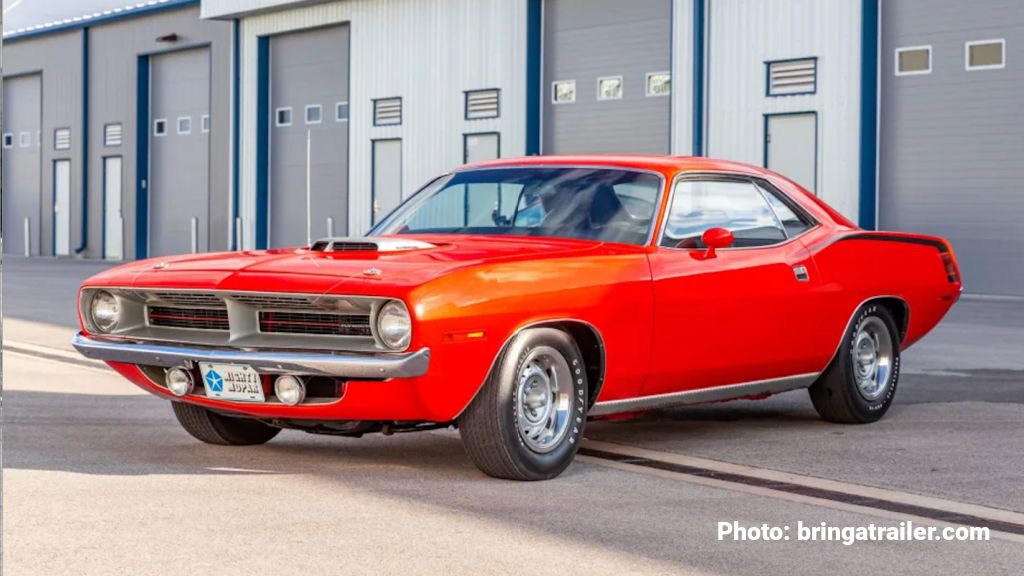
The 1970 Plymouth Hemi Cuda is a legend known for its raw power and aggressive styling.
Powered by a massive 426 Hemi engine that produced 425 horsepower, the Cuda was designed for speed and performance.
The 426 Hemi gets its name from the hemispherical combustion chambers in the engine design. The hemispherical design allowed larger valves and improved airflow, increasing power and performance.
Plymouth produced only 652 units of the Cuda 426 Hemi. In terms of performance, the car could reach top speeds of up to 140 mph, with a quarter-mile time of just over 13 seconds.
These impressive numbers helped solidify the Cuda 426 Hemi’s reputation as one of the most powerful and capable American muscle cars, with speed and acceleration that few other cars could match.
The 1970 Plymouth Cuda 426 Hemi is a true icon, embodying the raw power, speed, and performance that defined this era of American automotive history.
Its compact design, bold graphics, and powerful engine helped make it a standout during its time, with a reputation that endures today.
1969 Ford Mustang Boss 429
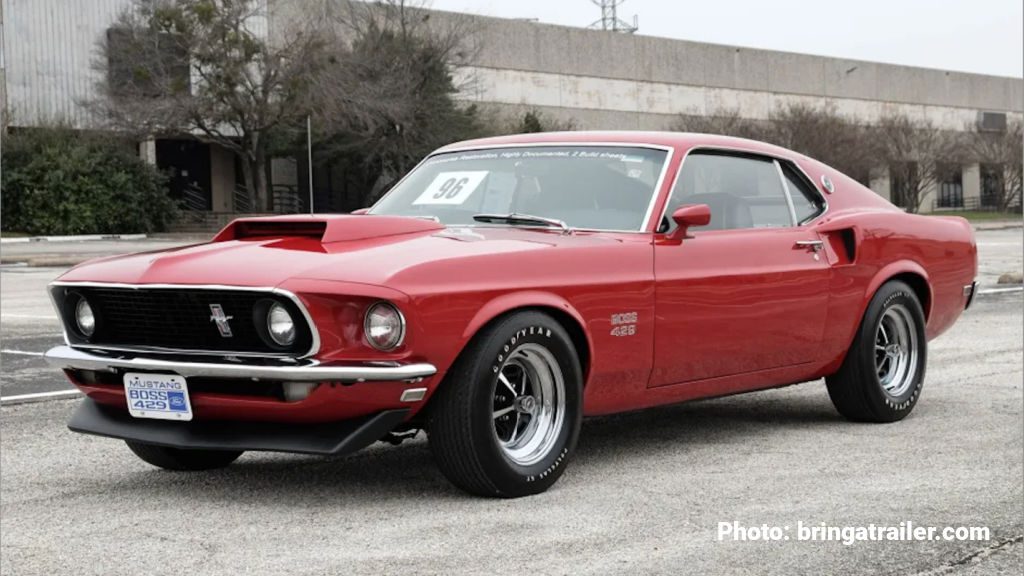
The 1969 Mustang Boss 429 was designed for NASCAR racing to compete against the 426 Hemi, but it also made an impression on the street with its aggressive style and powerful engine.
Kar Kraft was a Ford-contracted race shop responsible for building the 1969 Ford Mustang Boss 429. Specifically, they were tasked with modifying the Mustang to accommodate the massive Boss 429 engine. This included enlarging the engine compartment, modifying the suspension and brakes, and fitting special cooling systems. Ford contracted Kar Kraft because they lacked the production capacity to build the Boss 429 Mustang in-house.
The Boss 429 won 26 Grand National races, including its debut on March 9, 1969, at the Atlanta Motor Speedway. Its reputation for speed and performance helped make it a legend. The car’s rarity and historical significance also contribute to its status.
It was built with a massive 429 cubic inch V8 engine that could produce up to 375 horsepower, making it one of the most powerful NASCAR pony cars of its time. Ford built 859 Boss 429s. All were equipped with a 4-speed manual transmission.
1969 Pontiac GTO Judge Ram Air IV
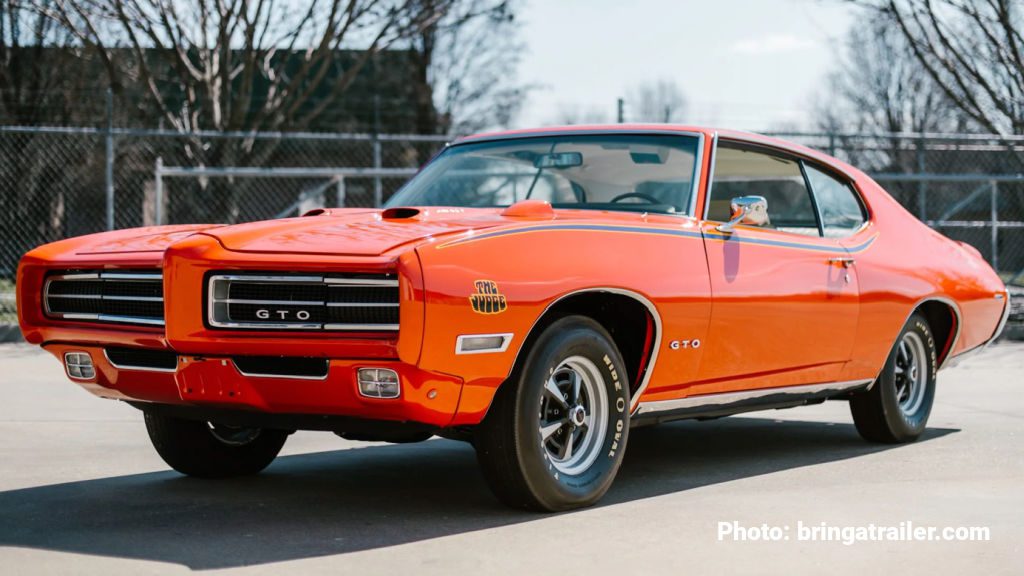
The 1969 Pontiac GTO Judge Ram Air IV is highly regarded for its high-performance capabilities and distinctive styling. The Judge was a unique variant of the Pontiac GTO, featuring a range of performance upgrades and a standout design. The first 2,000 units of production were painted Carousel Red.
The GTO Judge model was named after a popular catchphrase from the TV show “Rowan & Martin’s Laugh-In,” which featured a recurring sketch with a judge character played by Sammy Davis Jr. The catchphrase was “Here comes da judge!” that was a popular saying then. The name was meant to appeal to younger buyers and convey a sense of fun and irreverence.
The Ram Air IV package added a high-performance engine with a 400 cubic inch V8 that produced up to 370 horsepower and various other performance upgrades like a high-lift camshaft and high-flow cylinder heads. These modifications helped the Judge achieve impressive speed and acceleration, making it a head-turner wherever it went.
The Judge also had a distinctive design, with bold “The Judge” graphics on the front fenders and rear spoiler and a range of other stylistic flourishes like a rear spoiler and hood-mounted tachometer. These features helped the Judge stand out in a crowded field of American muscle cars, contributing to its lasting popularity among enthusiasts.
In terms of performance, the GTO Judge Ram Air IV was capable of reaching 60 mph in just 5.5 seconds, with a quarter-mile time of 13.8 seconds at 102 mph. It was also equipped with a heavy-duty suspension system and other upgrades that improved handling and stability at high speeds.
The GTO Judge Ram Air IV was produced in limited numbers, with only 627 units built.
1969 COPO Camaro 427
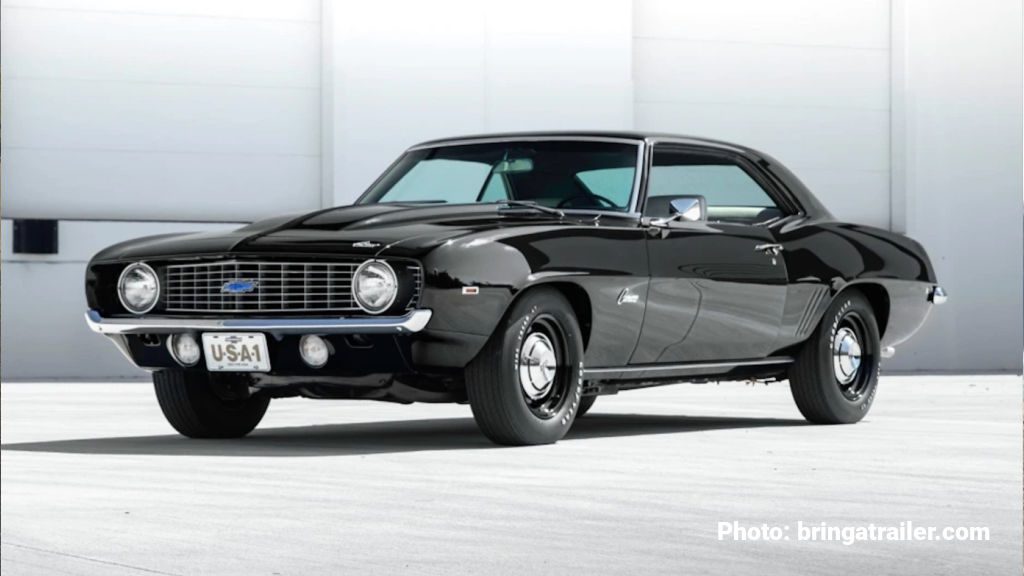
The 1969 COPO Camaro was not available to the general public. The loophole used to order 427s in a Camaro was through the Central Office Production Order (COPO) program. COPO was a special-order process used by Chevrolet dealerships to build high-performance models unavailable to the general public. This package was intended for use in Chevrolet’s full-size cars, but dealers could order it in the Camaro through the COPO program.
Fred Gibb Chevrolet ordered the first 50 COPO Camaros in La Harpe, Illinois. Gibb sold some of the COPO Camaros to Don Yenko, who modified and sold them under the Yenko name. The COPO Camaros were popular among performance enthusiasts, and many were purchased and modified by dealers and independent garages, including Yenko, Berger, and Baldwin Chevrolet.
In the case of the L72 427 Camaro, dealers could order one with the COPO 9561 package, which included the 427-cubic inch engine with 425 horsepower, a heavy-duty suspension, and other performance upgrades. Only 1,015 total were produced, with 201 going to Yenko Chevrolet.
However, the ZL1 COPO Camaro option was also available with an all-aluminum 427 cubic inch V8 engine, rated at 430 horsepower—the ultimate race version built to dominate the strip. The engine had aluminum cylinder heads, a high-rise aluminum intake manifold, and a four-barrel carburetor. The engine had a solid lifter camshaft, forged aluminum pistons, and a high-performance oiling system.
Chevrolet produced only 69 units of the COPO Camaro ZL1, making it an extremely rare and highly coveted collector’s item approaching values of 1M dollars. In terms of performance, the car could reach top speeds of up to 130 mph, with a quarter-mile time in the high 12-second range. These impressive numbers helped solidify the COPO Camaro 427’s reputation, delivering speed and acceleration that few other cars could match.
1968 Shelby GT500KR 428CJ
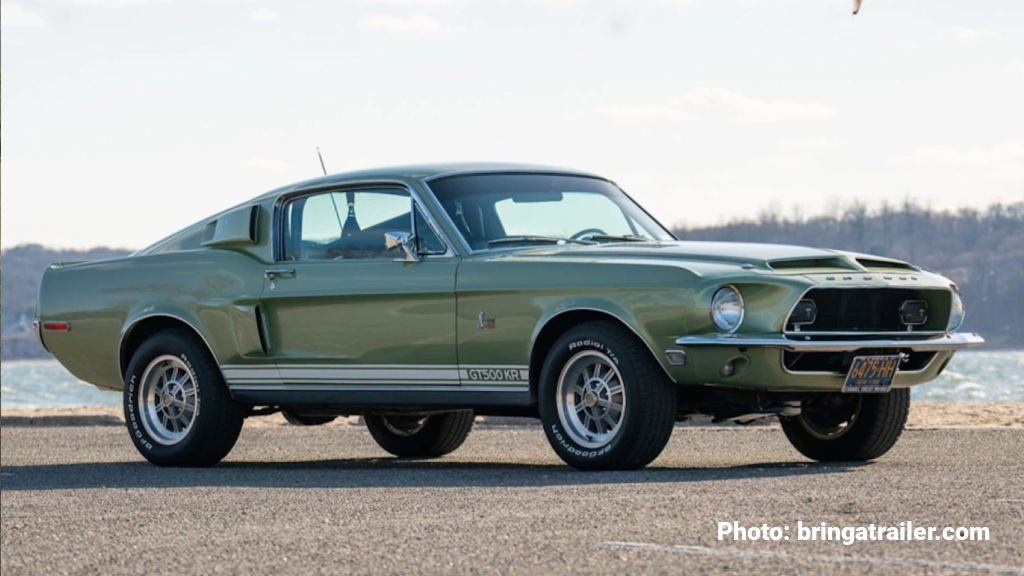
The 1968 Shelby GT500KR 428CJ was designed and built under the direction of Carroll Shelby. The “KR” stands for “King of the Road,” a nod to its high-performance capabilities and impressive power.
Carroll Shelby began by taking a Mustang Fastback and sending it to his Shelby American facility in California, upgrading it with the high-performance parts necessary to create the GT500KR. This included a 428 Cobra Jet V8 engine, larger brakes, stiffer suspension, and other performance upgrades. The car also featured distinctive styling elements such as a hood scoop, racing stripes, and GT500KR badging.
The 428 cubic inch V8 Cobra Jet engine generated 335 horsepower, with a range of performance upgrades that included a special camshaft and Holley four-barrel carburetor.
Shelby produced only 1,053 units of the GT500KR 428CJ, making it a rare and highly coveted collector’s item. In terms of performance, the car could reach top speeds of up to 125 mph, with a quarter-mile time of just over 14 seconds.
The 1968 Shelby GT500KR 428CJ is a true classic, embodying the style, power, and performance that defined this era of American automotive history.
1969 ½ Dodge Super Bee A12 440 Six Pack
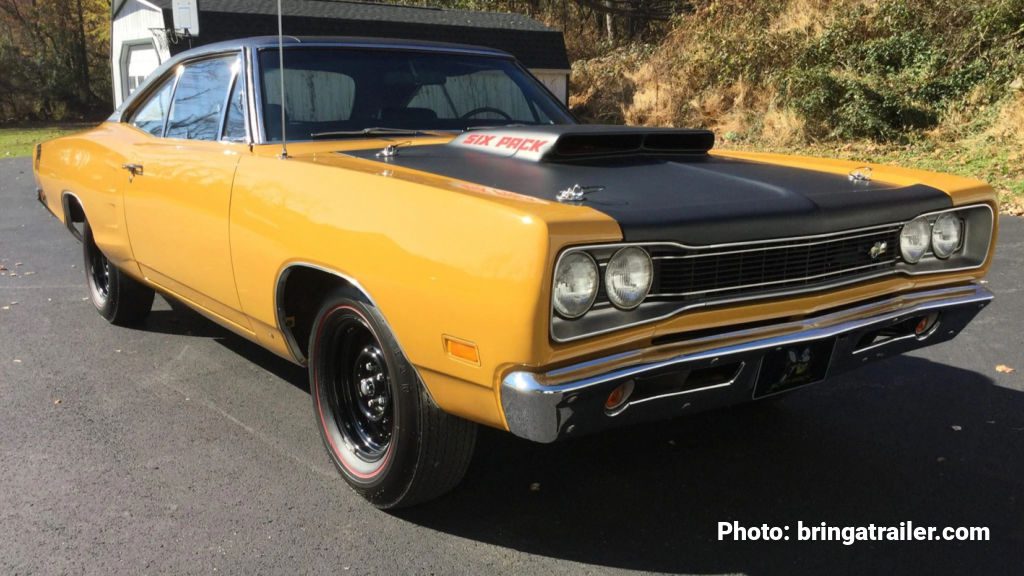
The iconic 1969 ½ Dodge Super Bee A12 was built to deliver raw power and impressive performance on the road. The A12 designation refers to the car’s special engine package, which included a 440 cubic inch V8 engine with 3x2bbl “Six Pack” carburetors that delivered 390 advertised horsepower.
The car also came with various performance upgrades, like a heavy-duty suspension, larger brakes, and a special fiberglass hood with a functional scoop. These modifications helped the Super Bee A12 achieve impressive speed and acceleration, making it a highly capable quarter-miler.
The A12 package was created in response to the demand for faster and more powerful American muscle cars, particularly from young buyers. Dodge and Plymouth aimed to offer a more affordable option to compete with other manufacturers’ high-performance models.
Plymouth also had its version of this street/strip powerhouse with its 1969 1/2 Plymouth Roadrunner. Both vehicles were capable of impressive quarter-mile times. However, the Road Runner A12 was favored by many due to its reputation as a street brawler and famous “beep-beep” horn.
Dodge produced only 1,487 units of the Super Bee A12, making it a rare and highly coveted collector’s item. According to Car and Driver, the Super Bee A12 could accelerate from 0 to 60 mph in just 5.5 seconds and complete a quarter-mile run in 13.5 seconds.
1969 Hurst Olds 455
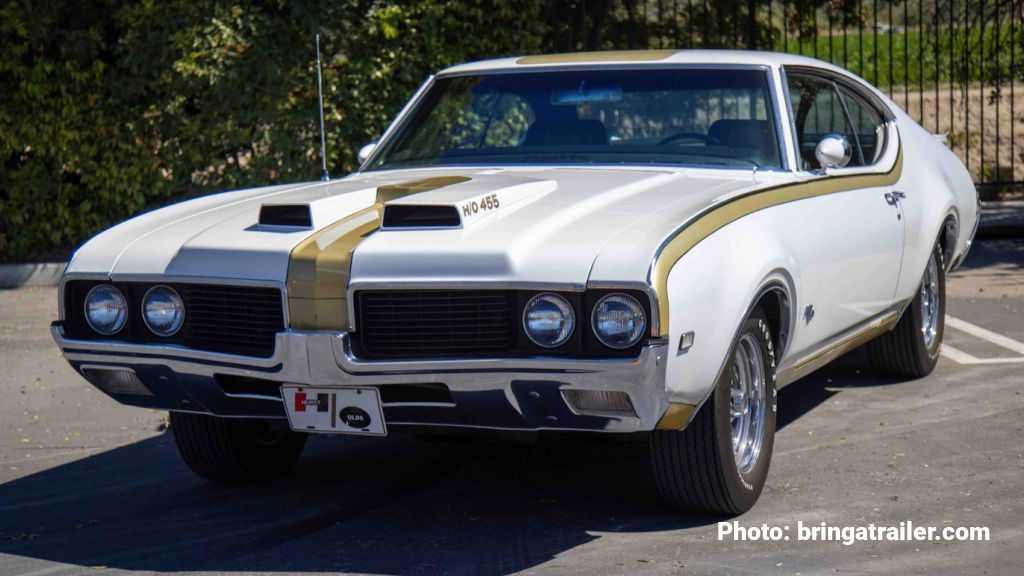
The 1969 Hurst Olds was a special edition vehicle that Hurst Performance and Oldsmobile jointly produced. It was built to commemorate the partnership between the two companies.
The Hust/Olds featured distinctive exterior styling elements such as Cameo White paint with Fire Frost Gold stripes, black pinstriping, a blacked-out 4-4-2 grille, dual snorkel hood scoops, a rear spoiler, color-keyed racing mirrors, and unique Hurst Olds badging.
The 1969 Hurst Olds was built at the Demmer Engineering facility in Lansing, Michigan. Oldsmobile contracted this facility to modify and install the Hurst package onto 906 Oldsmobile 4-4-2s.
Under the hood, Demmer Engineering modified the Hurst Olds’ 455 engine with improved cylinder heads, a high-rise aluminum intake manifold, a special camshaft, and a revised carburetor. These modifications increased the engine’s output to 380 horsepower and 500 lb-ft of torque.
This engine was mated to a Turbo Hydra-Matic 400 automatic transmission with a Hurst Dual/Gate shifter. The car also featured a limited-slip differential, heavy-duty suspension, and power disc brakes, making it a true performance machine.
1970 Buick GSX 455 Stage 1
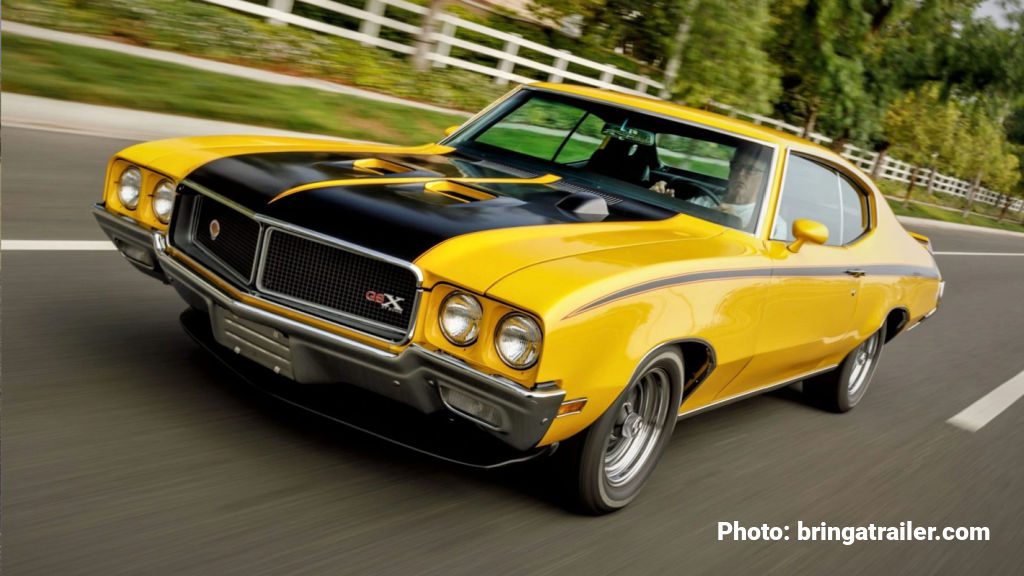
The 1970 Buick GSX is based on the Buick GS with a few important differences. The GSX was designed to deliver exceptional speed and performance on the road, with various upgrades and modifications that set it apart from the competition. The top engine choice was a 455 cubic inch V8 engine “Stage 1” option that delivered 360 horsepower and featured a range of performance upgrades like a heavy-duty suspension, larger brakes, and racing tires.
One of the key differences between the Buick GS and the GSX was the level of style that the GSX offered. The car was designed to be a more eye-popping version of the GS, with various upgrades and modifications that set it apart. The Buick GSX featured distinctive body stripes, decals, and performance-enhancing treatments like a functional hood scoop, front air dam, and rear spoiler. It was only available in two colors, including space-themed, Apollo White and Saturn Yellow.
According to Motor Trend, the GSX 455 Stage 1 could complete a quarter-mile run in just over 13 seconds, making it one of the fastest and most powerful American muscle cars of its time. The GSX Stage 1 was produced in limited numbers, with only 678 units built.
1973 AMC Javelin AMX 401
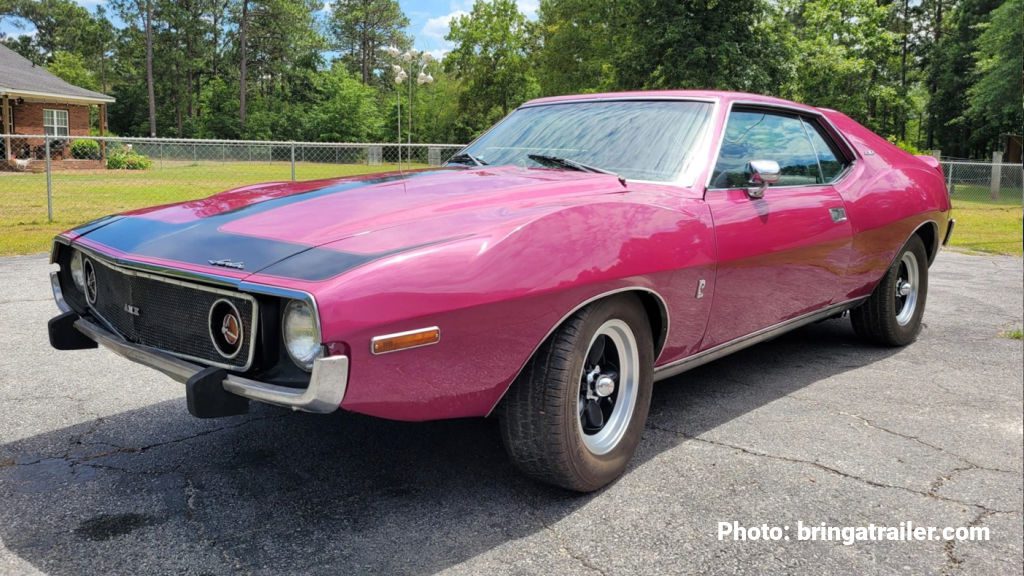
The 1973 AMC Javelin AMX 401 is a unique animal that the American Motors Corporation produced during the height of the muscle car era. The AMX was originally introduced in 1968 as a two-seater sports car, but by 1973 it had evolved into a more traditional muscle car focusing on speed and performance. The car was powered by a 401 cubic inch V8 engine that could produce up to 330 horsepower and was capable of impressive acceleration and speed.
Despite being produced by a smaller and less well-known automaker, the AMC Javelin AMX 401 was a serious contender in the market. Its unique styling and high-performance capabilities set it apart from other cars of its time and made it a popular choice for drivers looking for something different. The car was produced at AMC’s plant in Kenosha, Wisconsin, and was built in limited numbers compared to the American muscle cars produced by the Big Three automakers.
According to Road Test Magazine, the 1973 AMC Javelin AMX 401 could complete a quarter-mile run in just over 15 seconds, making it slower than some of its more powerful counterparts. Despite this, the car remains a distinctive vehicle today, thanks to its unique styling, impressive performance for its model year, and place in the supercar history.
1964 Pontiac GTO 389 Tri-power
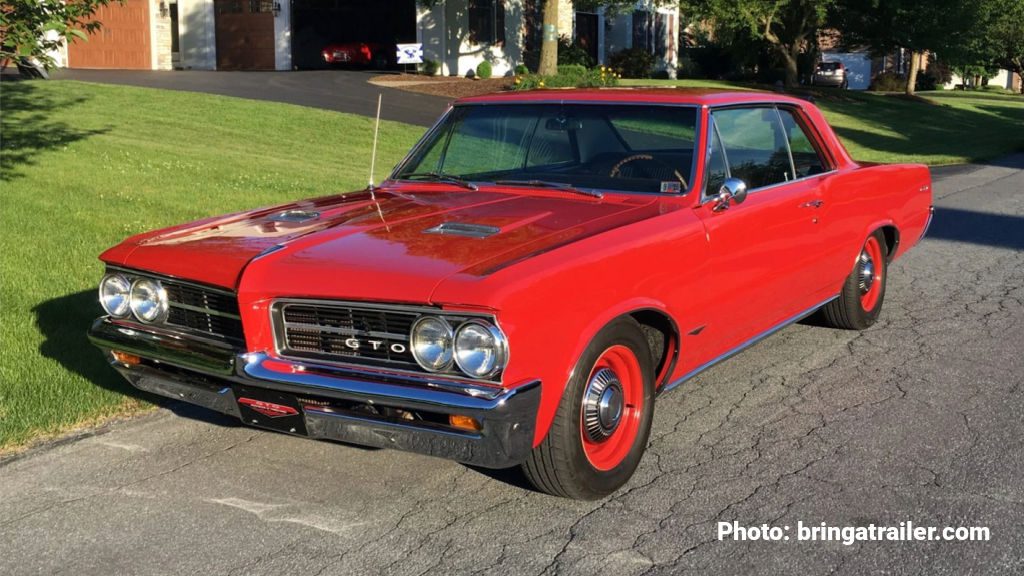
The 1964 Pontiac GTO 389 Tri-power is often credited with being the first American muscle car, and it has a rich history that goes back to the early 1960s. The GTO was originally introduced as an option package for the Pontiac Tempest, and it quickly became a popular choice among drivers who wanted a stylish and powerful car. The GTO’s success is largely due to the work of John Delorean, who was a key figure at Pontiac during this time.
Delorean saw the potential for a high-performance version of the Tempest and worked tirelessly to make the GTO a reality. The car was named after the Ferrari GTO, and it was equipped with a 389 cubic inch V8 engine that could produce up to 348 horsepower. This gave the GTO impressive speed and acceleration, and it quickly became a favorite among drag racers and car enthusiasts.
According to Motor Trend, the 1964 Pontiac GTO 389 Tri-power could complete a quarter-mile run in just over 14 seconds, making it the fastest Muscle Car in 1964. Pontiac estimated only selling 5,000 units in its debut year, so the 32,000 units sold was a welcomed surprise. Despite this, the Pontiac GTO set a new standard for performance and style in the automotive industry, and it paved the way for the many American muscle cars that would follow until the mid-1970s.
1970 Oldsmobile 4-4-2 W30 455
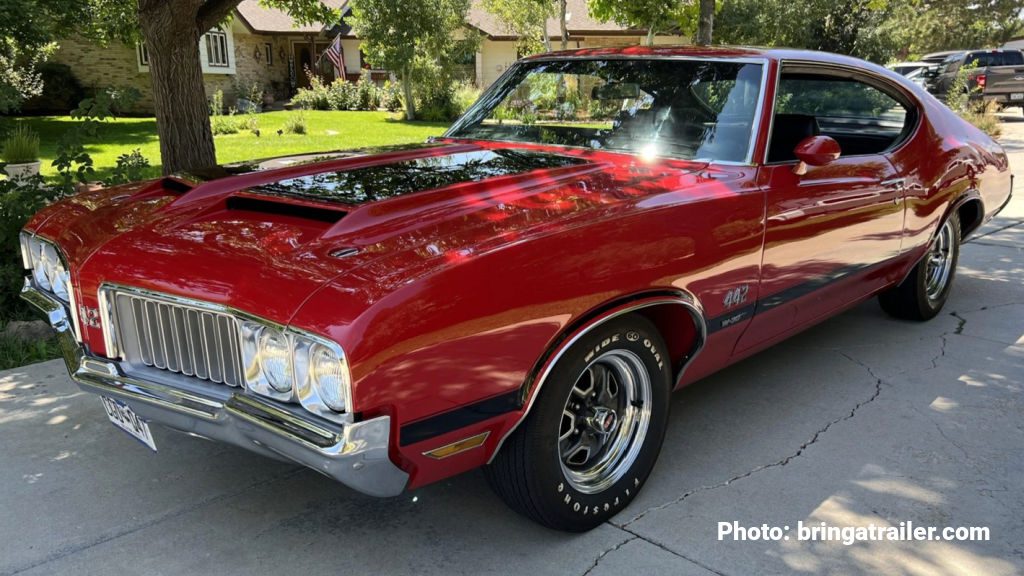
The 1970 Oldsmobile 4-4-2 W30 455 is a true muscle car with various performance upgrades and enhancements. The name “4-4-2” stands for a four-barrel carburetor, four-speed manual transmission, and dual exhaust, and it was designed to give drivers a powerful and responsive driving experience. The W30 package included additional features, such as a forced-air induction system, high-lift camshaft, and heavy-duty suspension.
According to Motor Trend, the 1970 Oldsmobile 4-4-2 W30 455 could complete a quarter-mile run in just over 13 seconds, making it one of the fastest cars of 1970. The 4-4-2 W30 was distinct from the standard 4-4-2 model due to its more powerful engine and other performance upgrades.
The Oldsmobile 4-4-2 W30 455 was part of the muscle car era, which saw American automakers producing high-performance vehicles designed for drag racing and other forms of high-speed driving. This period was characterized by intense competition between different manufacturers, with each company trying to outdo the others in speed, power, and performance.
The 4-4-2 W30 was a notable entry in this field, and it helped to solidify Oldsmobile’s reputation as a ground-pounding specimen and one of the best muscle cars.
The 1970 4-4-2 W30 was produced in limited numbers, with only 262 units built.
1973 Pontiac Trans Am SD-455
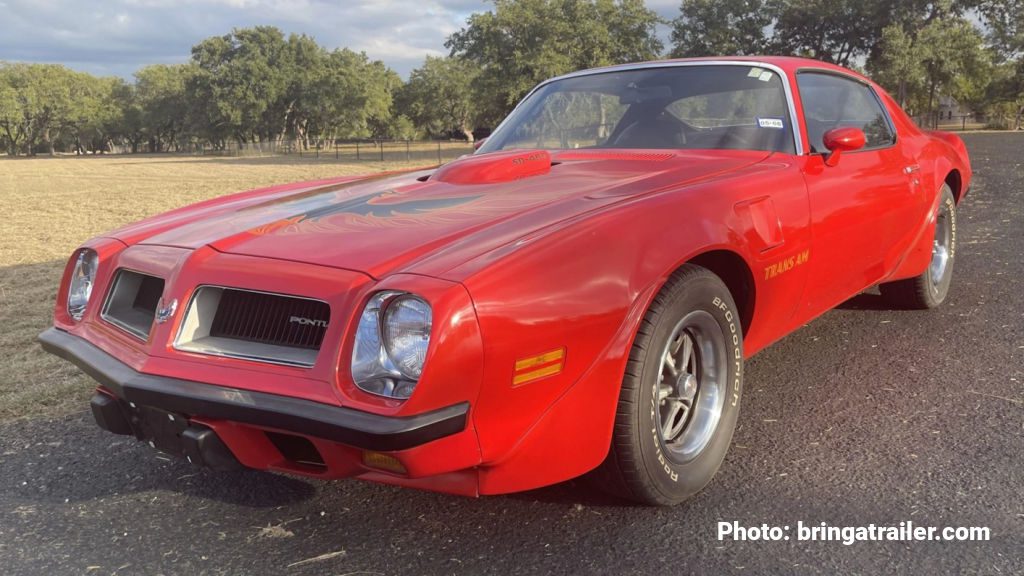
The 1973 Pontiac Trans Am SD-455 was a neck-snapping version of the popular Trans Am model, and it featured a range of performance upgrades that set it apart from the standard version. The “Super Duty” name was a nod to the car’s powerful engine, capable of producing up to 310 horsepower and 390 lb-ft of torque. This made it one of the fastest cars, with a quarter-mile time of just over 14 seconds.
The Trans Am SD-455 was equipped with various performance features, including a high-performance camshaft, high-flow exhaust system, and a larger carburetor.
The 1973 Pontiac Trans Am SD-455 competed with other pony cars of the time, such as the Chevrolet Camaro Z28 and the Ford Mustang Mach 1. Despite the oil crisis of the early 1970s, the Trans Am SD-455 remained popular with muscle car enthusiasts thanks to its powerful engine and distinctive styling.
The 1970 Trans Am SD-455 was produced in limited numbers, with only 252 units built.
1970 Ford Torino Cobra 429SCJ
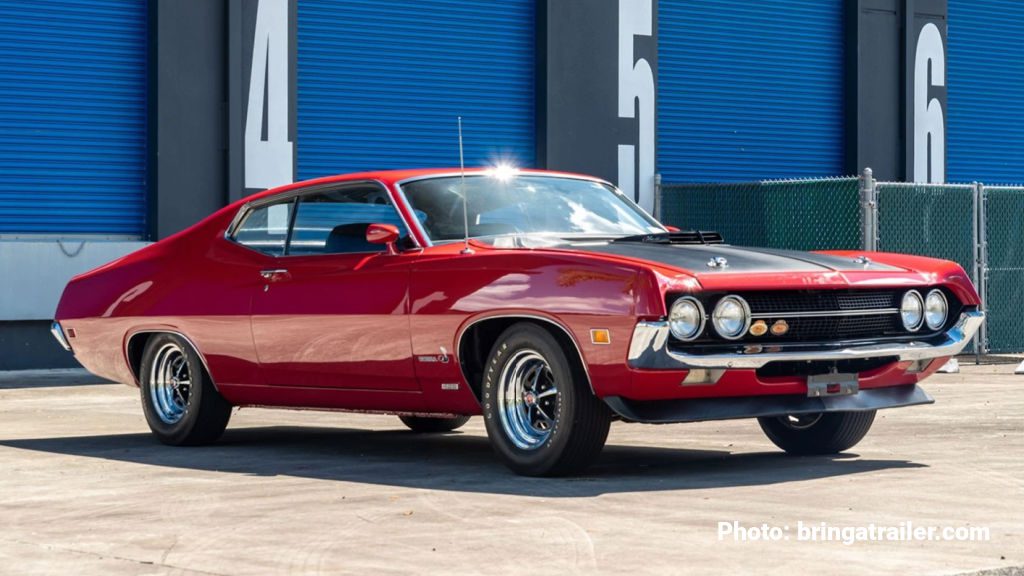
The 1970 Ford Torino Cobra was named after the deadly venomous snake for a reason.
It was a fierce and powerful machine that took the muscle car game to another level. It differed from the Torino GT due to the Cobra’s powerful engine, a 429 cubic inch V8 with an impressive 370 horsepower.
The Cobra also had a “shaker hood” scoop, a front spoiler, and a chrome engine dress-up kit. The car was available in several paint options, including Calypso Coral, Grabber Blue, and Vermillion.
The Cobra package also included performance upgrades such as power front disc brakes, heavy-duty suspension, and a four-speed manual transmission.
Optional equipment included a 3.50 or 3.91 rear axle ratio, a Drag Pack, which added a 4.30 rear axle ratio, and a Super Cobra Jet engine option.
According to a test conducted by Motor Trend in 1970, the Ford Torino Cobra could do a quarter-mile run in 14.9 seconds at a speed of 98.5 mph.
In terms of production, Ford only produced 7,675 Torino Cobra Hardtops in 1970, making it a relatively rare car. The Torino Cobra was highly sought after and considered one of the greatest Ford Muscle Cars.
The Torino Cobra also differed from other American muscle cars made by Ford and Mercury, such as the Mustang and Cougar. It was an ideal option for those wanting a muscle car with added comfort and style.
1970 Mercury Cougar Eliminator 428 SCJ
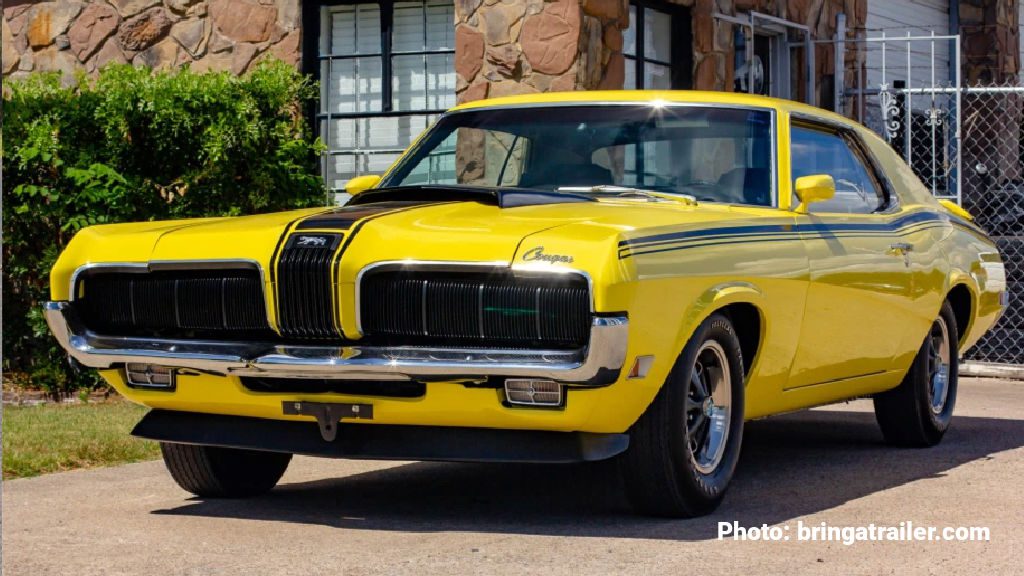
The 1970 Mercury Cougar Eliminator 428 SCJ was a high-performance version of the Cougar and was produced for only one year. The “Eliminator” name was chosen to convey the car’s speed and power. The car was built on the same platform as the Ford Mustang but had a more luxurious feel. The Eliminator package included several upgrades: suspension, power steering, power brakes, a front spoiler, a rear wing, and a hood scoop. The car’s interior featured high-back bucket seats, a center console, and a standard tachometer.
The Cougar Eliminator 428 SCJ was powered by a 428 cubic inch V8 engine with 335 horsepower and 440 lb-ft of torque. It could go from 0 to 60 miles per hour in 5.5 seconds and complete a quarter-mile run in just 13.9 seconds at 102 miles per hour. These numbers were achieved through a four-speed manual transmission and a 3.91 rear axle ratio.
Only 469 Cougar Eliminator 428 SCJs were built, making it a rare and highly collectible muscle car. The vehicle was produced as a response to the success of the Mustang and was part of a growing trend of pony cars with high-performance options. The Eliminator package was seen as a way to attract younger buyers to the Cougar brand and to compete with other American muscle cars of the time, such as the Chevrolet Camaro and Pontiac Firebird.
Conclusion
American muscle cars have a rich history and a devoted following of enthusiasts who appreciate their power, speed, and style. The vehicles on this list represent some of the most iconic and legendary muscle cars ever produced, each with its unique blend of performance, design, and rarity.
Whether you’re a die-hard muscle car fan or simply appreciate the beauty and power of these vehicles, it’s clear that muscle cars made in the USA will continue to be an enduring symbol of American automotive culture for years to come.

Get The Top 50 Fastest Muscle Cars chart. Includes year, model, engine, 1/4 mile times, and more—absolutely free!
Take Our Poll!
"*" indicates required fields

Ryan Wheaton
Ryan has owned muscle cars since 1986 and currently owns a 1972 Dodge Charger Rallye. He combines passion and experience to create engaging content for fellow muscle car enthusiasts. In 2018, he founded Muscle Cars Illustrated, authoring hundreds of articles on tips, history, and trends in the muscle car industry. He attends national car shows, auctions, and museums to stay current with the latest developments in the muscle car industry.
